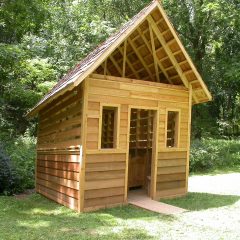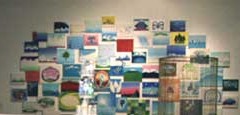Post by Amy Lipton
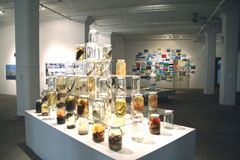
Installation shot from Exit Art’s Group exhibit, The Drop. Installation view: justin beal, Brandon Ballengee, Tony Hamboussi, Artists Formerly Known as Women, Nancy Drew, Lucia Pizzani, Andrea Polli (jars in foreground)
THE DROP exhibition at Exit Art in New York could really be titled The Wave, as in a new wave of artists whose works are focused on ecological issues. The Drop, up now through June 10, is specifically on the theme of water. Not a moment too soon either, as current issues of Time Magazine, Vanity Fair, Wired Magazine and the NY Times have recently devoted their cover stories to global warming and “green” issues. The contemporary art world has remained largely silent about these matters, but maybe this is about to change? The Drop is inspiring in that it covers a wide range of topics under the umbrella of Water. The show includes 26 artists and art collectives whose works examine various issues regarding the global water crisis. The key word in this exhibition is interdisciplinary, as many of the artists are working not only collectively with other artists but also with scientists, environmentalists, conservationists, government agencies, and citizens in order to tackle important water issues in specific regions. This dialogue between disciplines is the only way to begin solving our environmental problems and artists are catching on to this wave of thinking.


These rain and water-related song fragments appear on The Drop’s Curatorial Statement page. I like the references.
Artists works in THE DROP address global warming, pollution, water shortages, over-building, government regulations, and the privatization of water and public lands. The artworks and installations in the exhibition inform the audience about the global water crisis and propose ideas as to how we can reclaim, restore and co-exist with our natural environment. As ecological art has been a focus of my work for the past several years, I’ve singled out examples of some of the works in the show that inspired me to write.
The entrance to Exit Art’s cavernous space opens the show with The Dam by Arbuzo Virtmanis. Constructed out of cardboard and tape, this dam transports us metaphorically as well as physically through the entrance consolidating the sprawling exhibition into one unit. It empties its flow of visitors directly in front of the swamp, Bob Braine’s High Swamp of Manhattan (similar but smaller to Braine’s High Swamp of Lower Merion created last summer for the Main Line Art Center’s exhibition “Past Presence: Contemporary Reflections on the Main Line”)
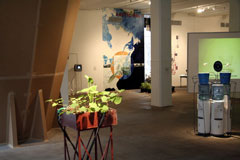
Installation shot from Drop. Arbuzo Virtmanis, Bob Braine, Aviva Rahmani, Ann Rosenthal & Steffi Domike, Christy Rupp, Fidel Sclavo
High Swamp (pictured above, the red structure with the plants in it) is a type of repurposed-infrastructure or architecture-landscape furniture. Humorously mimicking our vernacular industrial scenery, Braine has created a generic architectural structure that functions as a genetic reservoir for flora and fauna – a pocket ecosystem that would otherwise be entirely displaced. High Swamp also represents an ecologically functional monument to our indigenous surroundings.
Related to High Swamp is Jackie Brookner’s art in a pond. This living bio-sculpture titled I’m You is made of mosses, ferns and other plants growing on a stone and concrete form. Water mists over the sculpture, plants transform pollutants and toxins into nutrients and cleanse the water below where fish are happily swimming. The finger-like shapes of I’m You are based on microscopic structures that are found in some mosses. Their uncanny resemblance to human hands is a reminder that we humans are part of and related to larger natural patterns.


More music from the curators’ statement. You’ll just have to hum along.
Moving along past the dampness of swamps and misting mosses we come to Christy Rupp’s Public Water Bar- 5 Borough Taste Test & Visitor Vote Registry, an approachable and tempting sculpture for thirsty art travelers. The piece consists of 5 water dispensers for tasting samples from each NYC borough. Each viewer/taster can register their preference on a clipboard, helping to gather data. This blind test will determine which borough can boast the best tasting water. NYC is supposed to have one of the best tasting tap water systems in the country, this may be because it’s one of only 4 cities nationally where the drinking water comes unfiltered directly from it’s own watershed land that has not been over developed (the other 3 are Boston, S.F. and Portland, OR – progressive cities all).
Addressing another environmental concern about the threat of overdevelopment is Lillian Ball’s Leap of Faith. Her video/sculpture is based on an ongoing community project that is working to preserve a 12-acre wetland on the north fork of Long Island, NY. Projected onto a patch of sand, the video documents the delicate, endangered ecosystem of the Great Pond Wetlands and Dunes including wildlife, plants, and predators. This community based, activist artwork encompasses politics, conservation organizations and real estate interests.
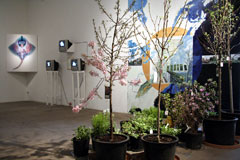
Installation view Brandon Ballengee, Peter Fend, Aviva Rahmani (fish on left)
Centrally located and visually dynamic is Brandon Ballengee’s large tower of glass specimen jars, Prelude to the Collapse of the Atlantic Food Chain. Ballengee’s work of the past several years has been focused on the decline of various animal species, this one takes a look at the food chain of the Atlantic Ocean. The tower consists of preserved jars of decomposers and producer species on the bottom tier. These are followed by a level of consumer species and finally, top-level predator species. Empty jars are placed throughout the pyramid representing species we have already depleted or extinguished completely. Over the past century, over-fishing, global climate change and habitat alteration have been destroying this interconnected pyramid.
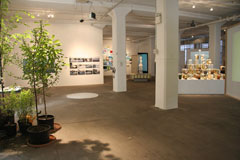
Aviva Rahmani, justin beal, Lillian Ball, Tony Hamboussi, Nancy Drew, Lucia Pizzani, Artists Formerly Known as Women, Brandon Ballengee
Nearby and related to Ballengee’s towering testament to declining sea life is another fish tale installation by Steffi Domike and Ann T. Rosenthal. Based in Pittsburgh, this artist team have been collaborating on projects concerning waterways and their geographic, cultural and historic narratives. Their inclusion in The Drop is titled Recipes for Catch & Release. The artists invite viewers to choose their favorite fish recipes from color-coded recipe cards that feature popular species of fish but they also include health advisories indicating how often the species can safely be eaten. The installation includes photographs of fishermen with their catch, a kitchen table with microscope, and a dissected white bass with organs in petri dishes for viewing with the microscope. Recipes for Catch & Release uses irony and humor to address the high levels of contaminants in our waterways and to understand how they become concentrated in the fish we eat. (to be continued tomorrow)
–Amy Lipton is Curator of Art at Abington Art Center and a regular contributor to artblog. Read about her Abington shows here and here. and read her last fall’s Chelsea roundup here.


